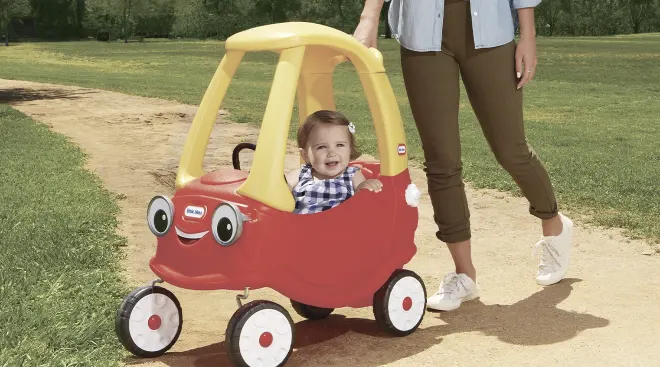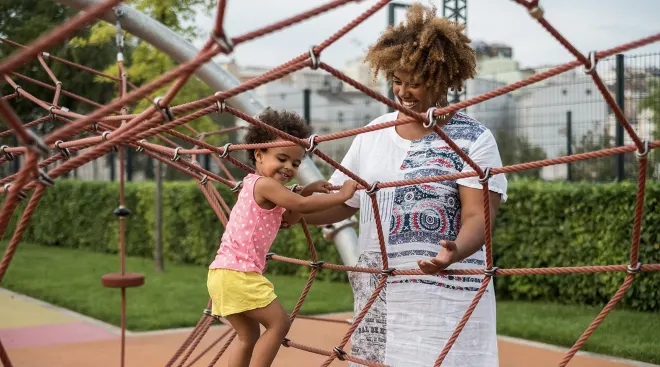Toddler Whining: Why It Happens and What to Do About It
Have you ever had your carefully laid plans ruined by a sudden attack of toddler whining? Picture this: You’re excited to spend the morning with your little one—maybe you’re heading to the zoo or their favorite playground. But, at some point, something goes awry. You’re stuck in traffic, you forgot to pack a snack or perhaps the wind blew the wrong way. Suddenly, your happy kiddo has been replaced by a whinier, crankier version of themselves. Rest assured, we’ve all been there. And when a toddler gets into this moody mode, there’s seemingly no way to reason with them.
As frustrating as it may be, it’s important to remember that toddler whining is developmentally appropriate—and, believe it or not, there are a few tactics and strategies that can help. Ready to rein in that sing-songy moaning and groaning? Read on for expert tips and tricks.
Simply put, toddlers whine because they want to be heard. At this age and stage, they’re still figuring out how to communicate and how to get their needs met. “Because they’re at the very beginning of learning about their feelings and their emotions, they really don’t have the language or ability to express what’s going on inside their bodies," says Jill DiPietro, LCSW, a social worker at Small Brooklyn Psychology in New York City.
When these feelings get to be too much for them to handle, they often respond with whining. “Children can become overwhelmed by their own experience and not know what to do,” says Martha Edwards, PhD, director of the Center for the Developing Child and Family at the Ackerman Institute for the Family in New York City. “Their discomfort may come out as a whine because it conveys their internal state.”
Of course, there’s another slightly more irritating explanation for toddler whining: It may have proven to be a successful strategy for them in the past. “They may want something and whine because it actually works to get what they want. The sound of whining is like nails on a chalkboard and this is likely to increase the effect that children have on their parents,” adds Edwards. Basically, you’ve caved in the past and your savvy little cutie took note. To that effect, it’s important you don’t inadvertently establish what DiPietro calls “unhelpful communication patterns.”
The good news? You can help foster healthy reactions and coping mechanisms so whining doesn’t become the norm. “With toddlers, we have this cool opportunity to teach emotional regulation skills and reinforce positive behaviors from an early age, before they are looking for that attention," she says. These tactics will not only help you deal with toddler whining when it pops up, but hopefully also stop it from happening in the first place.
Of course, occasional toddler whining is inevitable. It’s par for the course and completely normal. The key is to keep your cool and not condition them to think that whining is an acceptable means to get their way. Here’s what you can do to stop whining in its tracks.
1. Plan special one-on-one playtime
Proactively giving your kid attention is a great way to ward off whining before it even begins. DiPietro suggests setting aside 5 to 10 minutes each day (more is great if you can swing it) of special one-on-one playtime. Her suggestions? Set your phone (and other distractions!) aside so you can fully commit to the moment, refrain from using directive instructions or commands and let your child take the lead. Since language is an essential part of teaching emotional regulation, narrating your child’s actions during play can be helpful too. “When they develop language skills, they can identify first and foremost how they’re feeling, what the feelings are and, ultimately, what we can do about it," DiPietro says.
2. Praise the positive
All humans crave and respond well to positive reinforcement, and toddlers are no different. "If you’re seeing whining in your toddler, try catching moments when you see them using their words or staying calm,” says DiPietro. Avoid calling out the negatives and focus on the positives instead. “Offering specific praise is such an incredibly powerful tool to develop healthy communication patterns,” she says. Toddlers also appreciate what DiPietro calls “positive touch,” such as rubbing their back or giving a cuddle; this helps them feel more safe and secure.
3. Offer calm reassurance
It can be tough to stay serene when your toddler’s behavior is trying your patience, but remember that as adults, we need to act the part. “It’s our job to calmly step in and support toddlers as they are processing these big emotions,” says DiPietro. Along with offering support in the moment, you’re also showing your child what it looks like to keep your cool despite feeling frustrated. “You’re modeling the ability to stay calm. Things often don’t make sense to toddlers, and it can be incredibly difficult, but when we can physically stay present and model that calmness, it’s incredibly powerful—because children are little sponges and will do what we do,” says DiPietro.
4. Validate emotions
Toddlers may want things that don’t make sense, and sometimes they simply lack the understanding of why things can’t go their way. But even if you’re annoyed (or suppressing the urge to crack up laughing at the occasional ridiculousness of a whiny tantrum), it’s important to show your child that you’re naming and taking stock of their feelings. "Labeling a child’s emotions creates a sense of understanding and positive support,” says DiPietro.
5. Always underreact
Have you ever gotten visibly upset over your toddler’s whining, only to realize that your reaction made them complain or gripe even more? Your negative response can be fuel to the fire. Downplaying gracefully is the key to diffusing the situation, while simultaneously trying some of the suggestions above. “When we underreact to a child’s whining, we’re still providing reassurance and validation, but we’re not necessarily staying in that cycle of dysregulation,” says DiPietro. This segues nicely into the next tip.
6. Provide redirection
Unlike your tween or teen who might hold a grudge for weeks or months, toddlers are still in that delightful sweet spot where they can be easily distracted and don’t mind having their attention directed elsewhere. Once you’ve let your child know you hear their frustration, it’s time to move on. "Even a simple location change can help,” says DiPietro. You can offer a new toy or try a different activity to shift their focus.
7. Consider basic needs
Of course, even the most enticing redirection plan won’t work if your child is hungry, thirsty, tired or needs a diaper change. “Make sure you address these biological needs first,” advises DiPietro. Edwards also suggests that parents look at the big picture to see if there are routine tweaks that might be helpful: "Look to see when the whining occurs and whether there are patterns. For example, does it happen between meals when blood sugar is low? Does it occur more when they get a poor night’s sleep?” If you can identify a cycle, you might be able to improve your toddler’s mood and curb whining by giving them them what their body needs (more sleep, more fueling food, etc.).
8. Take care of yourself emotionally
Just like the airline staff tells you to put on your oxygen mask before helping your child with theirs, you also want to take care of your own emotional needs so you can best address those of your child. “Toddlers can be incredibly attuned to sensing the emotions of others, so we want to stay ahead of our emotions and notice when negative thought patterns creep in,” says DiPietro. You can utilize tried-and-true techniques such as deep breathing, progressive muscle relaxation (best done when you have time to yourself) or the use of positive affirmations. It’s also helpful to start to share these techniques with your child—again, that modeling comes into play. “I’ve seen kids as young as 4 use positive self-talk that has never been taught to them, but that they’ve picked up from their parents,” she says.
What’s more, rather than rushing to respond to your toddler’s whining, take a moment to check in with yourself. “We can interrupt this knee-jerk negative reaction when we slow down,” says Edwards. Dipietro calls this a “reverse time out,” elaborating that a little physical distance can help. “Obviously this doesn’t mean leaving your child in an unsafe situation, but if you can step away, try taking just a few minutes for some deep breaths before returning,” she suggests.
Even if you employ all the proactive strategies and respond to behavior appropriately, whining will happen from time to time. It’s true that life with a toddler can feel like an emotional rollercoaster ride, so remember to show yourself and your little one grace and compassion. This phase will pass.
Please note: The Bump and the materials and information it contains are not intended to, and do not constitute, medical or other health advice or diagnosis and should not be used as such. You should always consult with a qualified physician or health professional about your specific circumstances.
Plus, more from The Bump:
Jill DiPietro, LCSW, is a licensed clinical social worker at Small Brooklyn Psychology in New York City. She specializes in the diagnostic evaluation and treatment of children and adolescents. She has an advanced clinical social work degree with a specialization in mental health from Columbia University and holds a certification in parent-child interaction therapy (PCIT) by PCIT International.
Martha E. Edwards, PhD, is the founder and director of the Center for the Developing Child and Family at the Ackerman Institute for the Family in New York City.
Learn how we ensure the accuracy of our content through our editorial and medical review process.
Navigate forward to interact with the calendar and select a date. Press the question mark key to get the keyboard shortcuts for changing dates.




















































